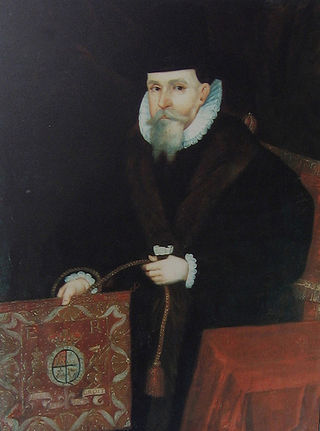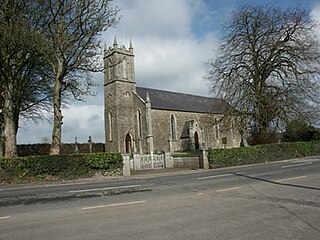Related Research Articles

Saint Patrick's Cathedral in Dublin, Ireland, founded in 1191 as a Roman Catholic cathedral, is currently the national cathedral of the Church of Ireland. Christ Church Cathedral, also a Church of Ireland cathedral in Dublin, is designated as the local cathedral of the Diocese of Dublin and Glendalough.

Adam Loftus was Archbishop of Armagh, and later Dublin, and Lord Chancellor of Ireland from 1581. He was also the first Provost of Trinity College Dublin.

Trim is a town in County Meath, Ireland. It is situated on the River Boyne and has a population of 9,194. The town is noted for Trim Castle – the largest Norman castle in Ireland. One of the two cathedrals of the United Dioceses of Meath and Kildare — St Patrick's cathedral — is located north of the river. Trim won the Irish Tidy Towns Competition in 1972, 1984, 2014 and 2022, and was the "joint" winner with Ballyconnell in 1974. Trim was historically the county town of Meath, but this title was passed on in 1898 to the larger, neighbouring town of Navan.

Duleek is a small town in County Meath, Ireland.

The Dean of St Patrick's Cathedral is the senior cleric of the Protestant St Patrick's Cathedral, Dublin, elected by the chapter of the cathedral. The office was created in 1219 or 1220, by one of several charters granted to the cathedral by Archbishop Henry de Loundres between 1218 and 1220.

Richard FitzRalph was a scholastic philosopher, theologian, and Norman Irish Archbishop of Armagh during the 14th century. His thought exerted a significant influence on John Wycliffe's.

Mullagh is a town, civil parish and townland in County Cavan, Ireland. As of 2016, the town's population was 1,348. It lies in the south-east of the county, at the junction of the R191 and the R194 regional roads near the towns of Virginia and Bailieborough.

Thomas Jones was Archbishop of Dublin and Lord Chancellor of Ireland. He was also Dean of St. Patrick's Cathedral and Bishop of Meath. He was the patrilineal ancestor of the Viscounts Ranelagh.

St. Werburgh's Church is a Church of Ireland church building in Dublin, Ireland. The original church on this site was built in 1178, shortly after the arrival of the Anglo-Normans in the town. It was named after St. Werburgh, abbess of Ely and patron saint of Chester. The current building was constructed in 1719. It is located in Werburgh Street, close to Dublin Castle.

Henry Ussher was an Irish Protestant churchman, a founder of Trinity College, Dublin, and Church of Ireland Archbishop of Armagh.
Henry Leslie was a Scottishman who became the Church of Ireland Bishop of Down and Connor from 1635 to 1661 and briefly Bishop of Meath from January to April 1661.
The Church of St. John the Evangelist was a Church of Ireland church located on the west side of Fishamble Street in the centre of Dublin, Ireland. It was founded in the 12th century, and a great many of its parish records survive.
Thomas Lancaster was an English Protestant clergyman, Church of Ireland Archbishop of Armagh from 1568.
Clonmethan is a townland and a civil parish in the ancient barony of Balrothery West, Fingal in Ireland. It is bordered by the parishes of Palmerstown to the west, Grallagh to the north, Hollywood to the northeast, Westpalstown to the east, Killossery to the southeast, Killsallaghan to the south, and Greenoge, County Meath to the southwest.

John Sterne (1660–1745) was an Irish churchman, bishop of Dromore from 1713 and then bishop of Clogher from 1717.
Charles Moore, 2nd Viscount Moore of Drogheda (1603-1643) was an Irish aristocrat noted for his leadership of Irish Royalist forces in northern Leinster during the early stages of the Irish Confederate Wars.
William Tisdall (1669–1735) was an Irish clergyman. He was well known in his own time as a writer on religious controversies, but he is now mainly remembered for his friendship with Jonathan Swift. The friendship was damaged by Tisdall's wish to marry Esther Johnson, Swift's beloved friend Stella.
William Bladen (1585–1663) was a bookseller and printer in London and Dublin in the 17th century. He served as Sheriff, Alderman and Mayor (1647–1648) of Dublin and was present in Dublin during the Irish Rebellion in 1641–1642.
Rt. Hon. Henry Blayney, 2nd Baron Blayney, Baron of Monaghan was the son of Edward Blayney, 1st Baron, and of Ann Loftus his wife, daughter of Adam Loftus, Archbishop of Dublin and sometime Lord Chancellor of Ireland, by his wife Jane Purdon.
References
- ↑ Bladens in Ireland by Karen Proudler, 2015, ISBN 978-0-9566831-7-5
- ↑ "Alumni Dublinenses : a register of the students, graduates, professors and provosts of Trinity College in the University of Dublin (1593–1860) George Dames Burtchaell/Thomas Ulick Sadleir Supplement p70: Dublin, Alex Thom and Co, 1935
- ↑ Bodleian Library, Oxford, Wood 507 (26), also a letter of the Rebels to Lady Offalia, mother to Lord Digby, to deliver up her Castle of Geshel and her response to them
- ↑ Records of the Church of England Clergy Database, appointment 25 March 1645 of Thomas Bladen, Vicar, location Rainham, Kent
- ↑ A Dictionary of Members of the Dublin Book Trade, 1550-1800, based on the Records of the Guild of St Luke the Evangelist, Dublin, by Mary Pollard, 2000
- ↑ The Works of Jonathan Swift, Vol. 6 by Sir Walter Scott, 1824
- ↑ The Works of Jonathan Swift, D.D. ... complete in six volumes, by Thomas Roscoe. New York: Derby & Jackson, 1861. Vol. 4, p. 536 (A Tripos)
- ↑ Registers of St John the Evangelist, Fishamble Street, Dublin, "death of Madam Bladen, wife to Dr Bladen on 8 August 1690"
- ↑ Vol. VII of the Book of Irish Families, Great and Small by Michael C. O'Laughlin, President I.G.F., Editor, Irish Family Journal, 1999
- ↑ Parish Registers for St Margaret's of Antioch, Rainham via Medway Council's site www.cityark.medway.gov.uk
- ↑ Bunbury v Bolton Chancery Case